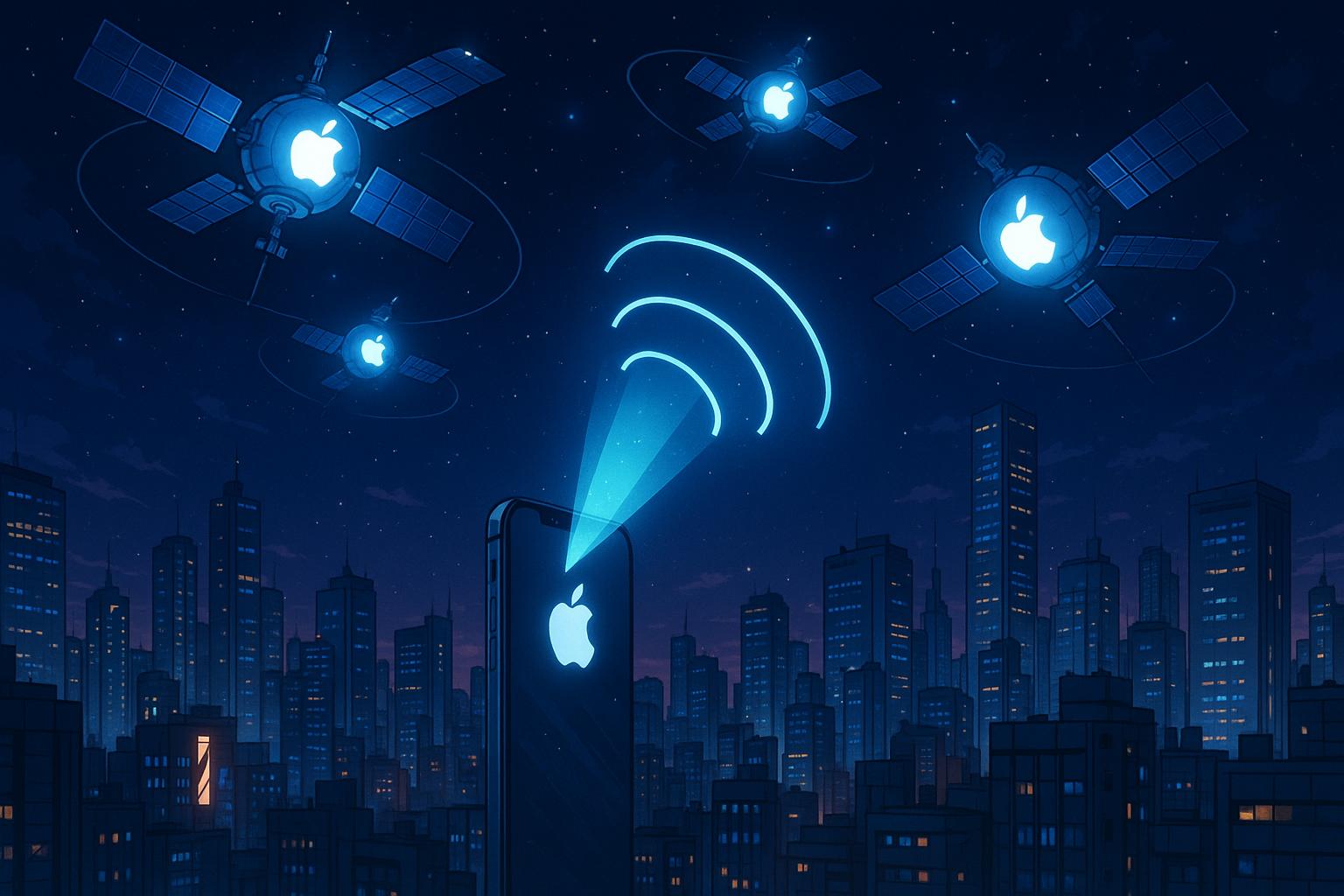Apple’s abandoned plans for a Starlink-style satellite internet service, known as Project Eagle, reveal a cautious strategy amid telecom partner concerns, yet the tech giant continues to expand satellite features on iPhones and explores new partnerships, positioning itself for a future in space-based connectivity.
The landscape of satellite internet is evolving dramatically, with major players emerging from the realm of technology to offer unprecedented connectivity. Recent revelations have shed light on an ambitious plan by Apple to establish its own satellite internet service, dubbed “Project Eagle,” which reflects the company’s long-standing interest in providing innovative solutions for mobile connectivity.
According to a report, Apple initiated Project Eagle in 2015, envisioning a home-based satellite internet service akin to Elon Musk’s Starlink. The plan involved launching thousands of satellites to create a robust network that would enable users to access the internet via antennas installed on their properties. This would not only affirm Apple’s commitment to enhancing connectivity, but also align with its broader strategy of self-reliance—much like its successful transition to designing its own silicon chips.
The collaboration with aerospace giant Boeing was a key element in developing this project, as discussions were held regarding the potential for satellite launches designed specifically for iPhone connectivity and broader home internet use. However, these plans were ultimately shelved. CEO Tim Cook expressed concerns about potential backlash from Apple’s telecommunications partners, questioning the sustainability of their existing relationships should Apple enter such a competitive space. Initially, the service was anticipated to launch in 2019, but these strategic considerations led to a notable pivot away from satellite initiatives.
Despite this setback, Apple has not entirely retreated from the realm of satellite technology. The company successfully integrated satellite connectivity features into its iPhone 14 series, enabling users to send emergency text messages in scenarios where traditional cellular service is unavailable. This innovation underscores Apple’s commitment to safety and connectivity, especially in remote or emergency situations. The Emergency SOS feature, which came into operation in late 2022, relies on a $450 million investment aimed at enhancing the infrastructure of Globalstar, a company that provides satellite services across the United States.
Moreover, new developments signal that Apple is actively exploring further satellite integrations. Reports indicated a collaboration with Globalstar, hinting at expanding the satellite capabilities of the iPhone, with upcoming enhancements that could broaden the range of services offered. The idea of integrating voice and data services—even in areas lacking cellular coverage—while still in its early stages, could signify the deeply embedded role satellite technology may play in the future of Apple’s product offerings.
Yet, as Apple navigates this complex terrain, competitive pressures are mounting from established players like SpaceX’s Starlink. Notably, reports suggest that SpaceX has raised concerns over Apple’s potential foray into satellite communications, fearing conflicts over spectrum rights that could stifle its own initiatives. Apple’s earlier discussions with SpaceX to connect iPhones to its Starlink network have yet to yield a formal agreement, illustrating the intricate complexities of this burgeoning market.
The dynamics of satellite internet are rapidly shifting, not just due to player competition but also advancements in technology. The notion of satellite-based connectivity is being further propelled by companies like AST SpaceMobile, which has made significant strides in creating a constellation that could enable mobile broadband services directly from space. Their recent achievements in demonstrating two-way communication using unmodified smartphones signal transformative possibilities in satellite technology.
In this evolving scenario, Apple’s initial aspirations for Project Eagle have not entirely dissipated and may still find fruition in future innovations. As the demand for reliable global connectivity intensifies, the journey of satellite internet—marked by bold visions, strategic partnerships, and competitive rivalries—could reshape how consumers access digital services, potentially positioning Apple once again at the forefront of this technological evolution.
Reference Map:
Source: Noah Wire Services
- https://www.techtimes.com/articles/310491/20250527/apple-wanted-starlink-like-satellite-internet-service-according-unveiled-project-eagle-plans.htm – Please view link – unable to able to access data
- https://www.apple.com/newsroom/2022/11/emergency-sos-via-satellite-made-possible-by-450m-apple-investment/ – In November 2022, Apple announced a $450 million investment from its Advanced Manufacturing Fund to support Emergency SOS via satellite for iPhone 14 models. This service enables users to communicate with emergency services when outside cellular and Wi-Fi coverage, utilizing Globalstar’s satellite network and ground stations across the US. The investment focuses on enhancing Globalstar’s infrastructure, including the deployment of new high-power antennas, to ensure reliable satellite connectivity for iPhone users in remote areas.
- https://m.economictimes.com/industry/cons-products/electronics/apple-and-spacex-link-up-to-support-starlink-satellite-network-on-iphones/amp_articleshow/117672762.cms – In January 2025, Apple collaborated with SpaceX and T-Mobile to integrate Starlink satellite capabilities into iPhones. This partnership allows users to send texts via satellite in areas without cellular service, with plans to expand into data and voice services. The feature operates automatically, distinguishing itself from Apple’s existing Globalstar service, and is currently in beta testing in the US, with future plans for broader deployment.
- https://appleinsider.com/articles/25/03/31/apples-satellite-plans-could-be-stalled-by-elon-musks-starlink – Apple’s satellite communication initiatives face challenges due to competition from SpaceX’s Starlink. SpaceX has reportedly urged federal regulators to impede Apple’s satellite expansion, citing spectrum rights issues. Despite previous discussions between Apple and SpaceX about connecting iPhones to Starlink satellites, no agreement has been reached, potentially hindering Apple’s satellite communication plans.
- https://9to5mac.com/2023/06/30/iphone-satellite-internet-features/ – In June 2023, Globalstar hinted at expanding iPhone satellite features in an FCC filing. Apple, in partnership with Globalstar, had previously introduced Emergency SOS via satellite, allowing users to contact emergency services without cellular coverage. The new filing suggests potential developments in satellite connectivity, possibly including internet services, though specific details remain unconfirmed.
- https://www.wired.com/story/satellite-internet-will-let-us-put-ai-in-everything/ – Apple has invested $1.5 billion into satellite company Globalstar to build a constellation enabling Apple devices to use features like Emergency SOS and car crash detection in remote areas without cell signals. This investment aims to provide global coverage, ensuring devices can connect to satellites regardless of location, and highlights the potential of satellite internet to integrate AI into various applications.
- https://en.wikipedia.org/wiki/AST_SpaceMobile – AST SpaceMobile is a publicly traded satellite manufacturer based in Midland, Texas, building the SpaceMobile satellite constellation to provide space-based cellular broadband. Its BlueWalker 3 prototype and BlueBird satellites are among the largest commercial communications arrays in low Earth orbit. In April 2023, AST SpaceMobile achieved the first space-based two-way telephone call with unmodified smartphones using the BlueWalker 3 satellite, marking a significant advancement in satellite communication technology.













